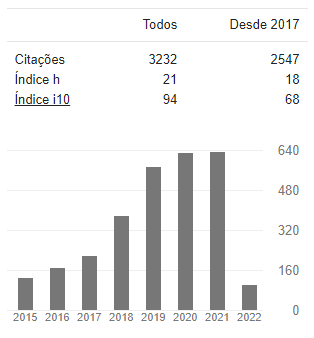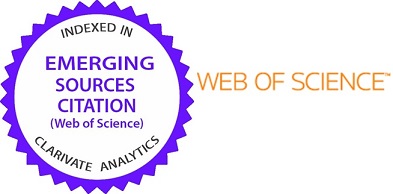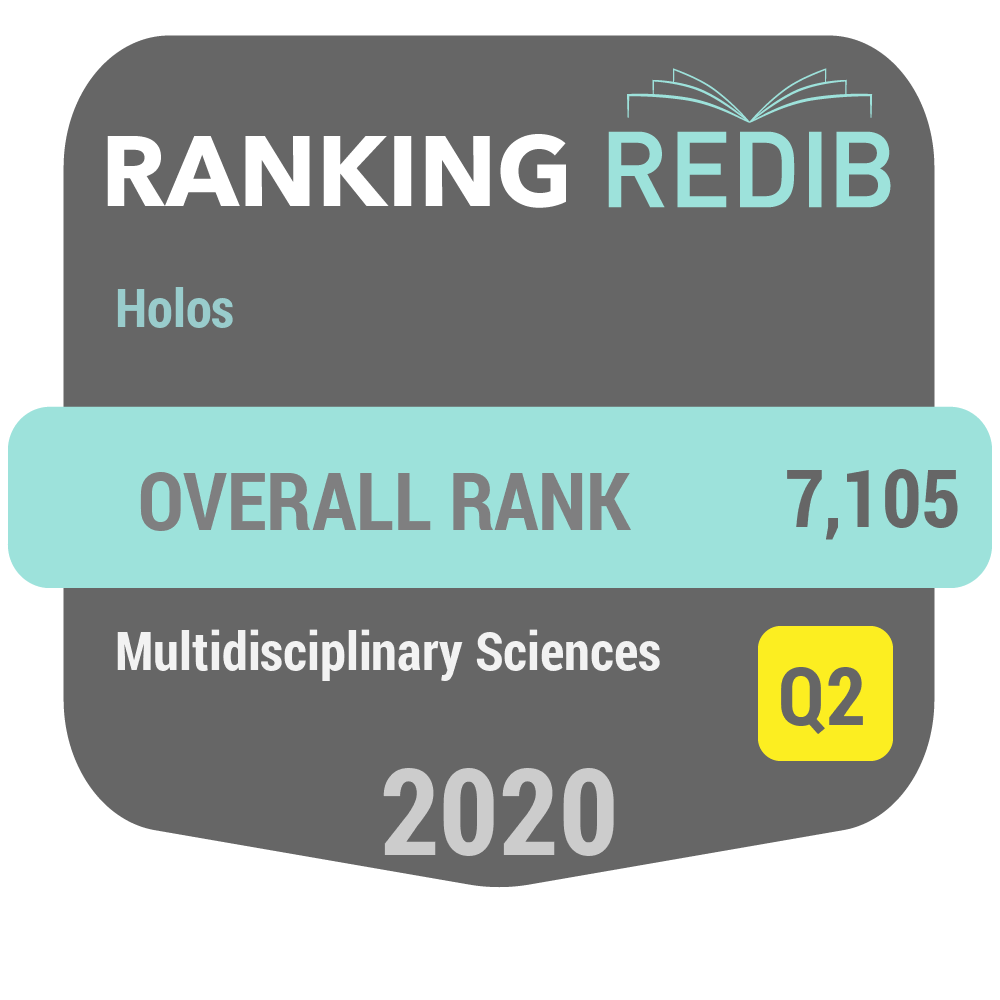AVALIAÇÃO DOS FATORES ENVOLVIDOS NA EXTRAÇÃO DE LIPÍDIOS DA BIOMASSA DA MICROALGA CHLORELLA MINUTÍSSIMA VIA SOLVENTES
DOI:
https://doi.org/10.15628/holos.2017.5655Palavras-chave:
Extração via solventes, Taguchi, Lipídios, Biomassa úmida, Chlorella minutíssimaResumo
As microalgas têm se tornado uma fonte promissora de energia renovável; além de fornecerem lipídios, carboidratos, proteínas, vitaminas e pigmentos, dentre outras diversas substâncias de alto valor agregado, contribuem enormemente para a redução do efeito estufa na atmosfera, ao consumirem o dióxido de carbono pela realização de fotossíntese. Os lipídios representam uma importante fonte de matéria prima para a obtenção de biocombustíveis, tal como o biodiesel. Um dos processos de obtenção de lipídios de excelente custo benefício é a extração via solventes, utilizando clorofórmio e metanol. Visando a obtenção do maior rendimento em lipídios por grama de biomassa, foram extraídos lipídios da biomassa da microalga marinha Chlorella minutíssima, empregando um arranjo ortogonal de Taguchi com o estudo simultâneo de quatro fatores que influenciam neste processo: umidade da biomassa, proporção entre os solventes, quantidade total de solventes utilizada e tempo de ultrassom para potencializar a quebra da parede celular, facilitando a liberação destes lipídios. Obteve-se um teor de 20% em lipídios, pelo emprego de uma biomassa com 64% de umidade, uma proporção de clorofórmio: metanol: água de 5,7: 3: 1, com um total de 33 mL de solventes e em apenas 70 minutos de ultrassom. Os lipídios extraídos foram transesterificados em biodiesel etílico via catálise ácida, obtendo-se uma conversão de 94,45%.
Downloads
Referências
Adam, F., Abert-Vian, M., Peltier, G., & Chemat, F. (2012). “Solvent-free” ultrasound-assisted extraction of lipids from fresh microalgae cells: A green, clean and scalable process. Bioresource Technology, 114, 457–465. http://doi.org/10.1016/j.biortech.2012.02.096
Arora, N., Patel, A., Pruthi, P. A., & Pruthi, V. (2016). Synergistic dynamics of nitrogen and phosphorous influences lipid productivity in Chlorella minutissima for biodiesel production. Bioresource Technology, 285530. http://doi.org/10.1016/j.biortech.2016.02.112
Balasubramanian, R. K., Yen Doan, T. T., & Obbard, J. P. (2013). Factors affecting cellular lipid extraction from marine microalgae. Chemical Engineering Journal, 215–216, 929–936. http://doi.org/10.1016/j.cej.2012.11.063
Bligh, E. G., & Dyer, W. J. (1959). Canadian Journal of Biochemistry and Physiology. Canadian Journal of Biochemistry and Physiology, 37(8), 389–395. http://doi.org/dx.doi.org/10,1139/cjm2014-0700
Cardoso, A. S., Eliza, G., Vieira, G., & Kappes, A. (2011). O uso de microalgas para a obtenção de biocombustíveis. In Revista Brasileira de Biociência (Vol. 9, pp. 542–549).
Chatsungnoen, T., & Chisti, Y. (2016). Optimization of oil extraction from Nannochloropsis salina biomass paste. Algal Research, 15, 100–109. http://doi.org/10.1016/j.algal.2016.02.015
Cheah, W. Y., Show, P. L., Chang, J.-S., Ling, T. C., & Juan, J. C. (2015). Biosequestration of atmospheric CO2 and flue gas-containing CO2 by microalgae. Bioresource Technology, 184, 190–201. http://doi.org/10.1016/j.biortech.2014.11.026
Chisti, Y. (2007). Biodiesel from microalgae. Biotechnology Advances, 25(3), 294–306. http://doi.org/10.1016/j.tibtech.2007.12.002
Converti, A., Casazza, A. A., Ortiz, E. Y., Perego, P., & Del Borghi, M. (2009). Effect of temperature and nitrogen concentration on the growth and lipid content of Nannochloropsis oculata and Chlorella vulgaris for biodiesel production. Chemical Engineering and Processing: Process Intensification, 48(6), 1146–1151. http://doi.org/10.1016/j.cep.2009.03.006
Derner, R. B., Ohse, S., Villela, M., Carvalho, S. M. De, & Fett, R. (2006). Microalgas, produtos e aplicações. Ciência Rural, 36(6), 1959–1967. http://doi.org/10.1590/S0103-84782006000600050
Dos Santos, R. R., Moreira, D. M., Kunigami, C. N., Aranda, D. A. G., & Teixeira, C. M. L. L. (2015). Comparison between several methods of total lipid extraction from Chlorella vulgaris biomass. Ultrasonics Sonochemistry, 22, 95–99. http://doi.org/10.1016/j.ultsonch.2014.05.015
Du, Y., Schuur, B., Kersten, S. R. A., & Brilman, D. W. F. (2015). Opportunities for switchable solvents for lipid extraction from wet algal biomass: An energy evaluation. Algal Research, 11, 271–283. http://doi.org/10.1016/j.algal.2015.07.004
Ferreira, S. P., Souza-soares, L. De, Alberto, J., & Costa, V. (2013). Revisão : microalgas : uma fonte alternativa na obtenção de ácidos gordos essenciais Review : microalgae : an alternative source to obtain essential fatty acids. SCAP Sociedade de Ciências Agrárias de Portugal, 36(3), 275–287.
Garcia, C. M. (2006). Transesterificação de óleos vegetais. Universidade Estadual de ampinas, Instituto de Química.
Garoma, T., & Janda, D. (2016). Investigation of the effects of microalgal cell concentration and electroporation, microwave and ultrasonication on lipid extraction efficiency. Renewable Energy, 86, 117–123. http://doi.org/10.1016/j.renene.2015.08.009
He, Y., Chen, L., Zhou, Y., Chen, H., Zhou, X., Cai, F., … Guo, Z. (2016). Analysis and model delineation of marine microalgae growth and lipid accumulation in flat-plate photobioreactor. Biochemical Engineering Journal, 111, 108–116. http://doi.org/10.1016/j.bej.2016.03.014
Koller, M., Muhr, A., & Braunegg, G. (2014). Microalgae as versatile cellular factories for valued products. Algal Research, 6(PA), 52–63. http://doi.org/10.1016/j.algal.2014.09.002
Kwietniewska, E., Tys, J., Krzeminska, I., & Koziel, W. (2012). Microalgae - Cultivation and Application of Biomass as a Source of Energy: A Review. Instytut Agrofizyki. http://doi.org/10.1017/CBO9781107415324.004
Loures, C. C., Amaral, M. de S., Laiate, J., Da Rós, P. C. M., De Castro, H. F., G, M. M. A., & Siva, M. B. (2015). Assembling of a bubble-column photobioreactor for the cultivation of a marine microalgae Chlorella minutissima. In Iv Solabiaa Latin American Congress. Florianópolis, Brazil.
Mata, T. M., Martins, A. A., & Caetano, N. S. (2010). Microalgae for biodiesel production and other applications: A review. Renewable and Sustainable Energy Reviews, 14(1), 217–232. http://doi.org/10.1016/j.rser.2009.07.020
Mesko, F., & Jacob-lopes, E. (2012). Biodiesel derived from microalgae: Advances and perspectives. In Química Nova (Vol. 35, pp. 2013–2018).
Milano, J., Ong, H. C., Masjuki, H. H., Chong, W. T., Lam, M. K., Loh, P. K., & Vellayan, V. (2016). Microalgae biofuels as an alternative to fossil fuel for power generation. Renewable and Sustainable Energy Reviews, 58, 180–197. http://doi.org/10.1016/j.rser.2015.12.150
Neofotis, P., Huang, A., Sury, K., Chang, W., Joseph, F., Gabr, A., … Polle, J. E. W. (2016). Characterization and classification of highly productive microalgae strains discovered for biofuel and bioproduct generation. Algal Research, 15, 164–178. http://doi.org/10.1016/j.algal.2016.01.007
Patil, J. A., & Honaguntikar, P. (2014). An Overview on Developments in Biodiesel Production from Algae. International Journal of Science and Research (IJSR), 3(12), 102–106.
Reddy, H. K., Muppaneni, T., Sun, Y., Li, Y., Ponnusamy, S., Patil, P. D., … Deng, S. (2014). Subcritical water extraction of lipids from wet algae for biodiesel production. Fuel, 133, 73–81. http://doi.org/10.1016/j.fuel.2014.04.081
Smedes, F., & Askland, T. K. (1999). Revisiting the development of the Bligh and Dyer total lipid determination method. Marine Pollution Bulletin, 38(3), 193–201. http://doi.org/10.1016/S0025-326X(98)00170-2
Smedes, F., & Thomasen, T. K. (1996). Evaluation of the Blight and Dyer lipid determination method. Marine Pollution Bulletin, 32(1), 681–688.









































